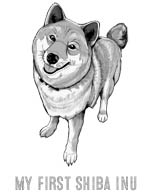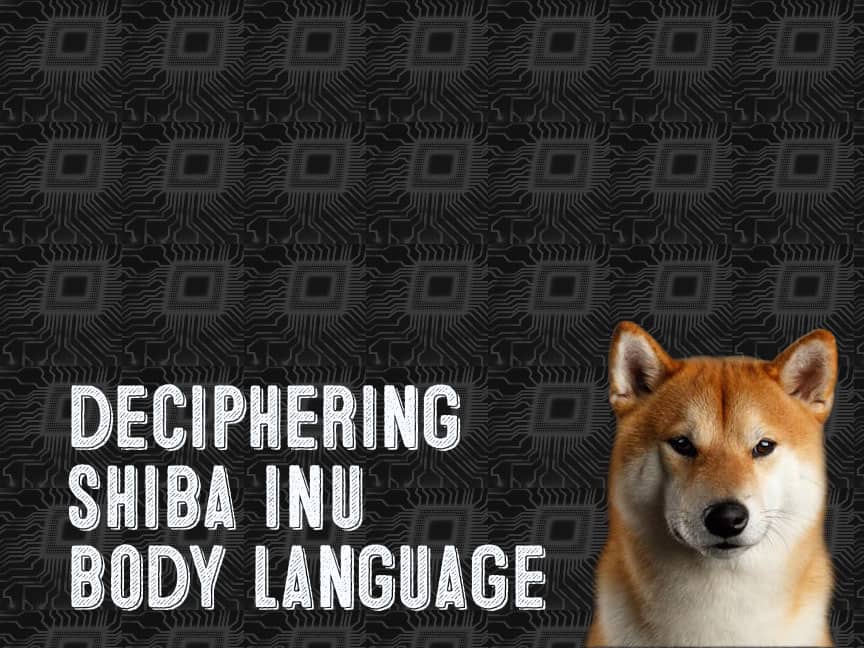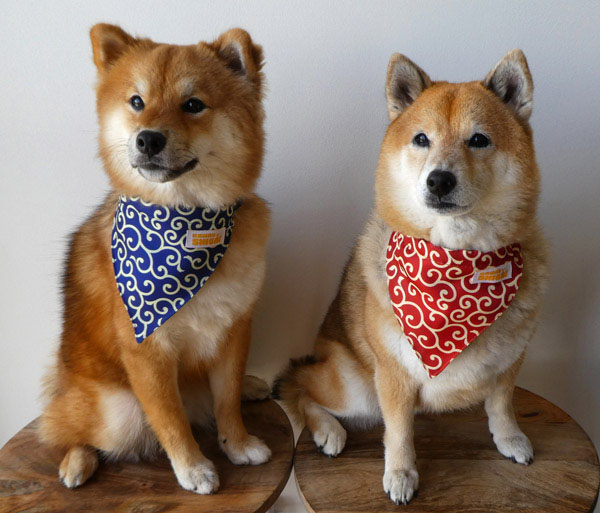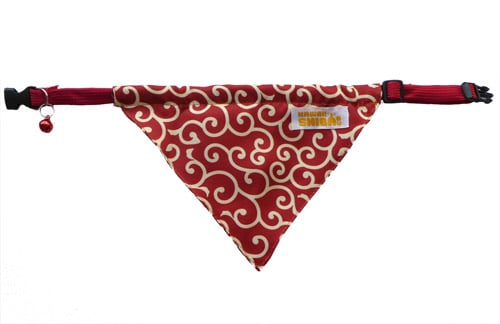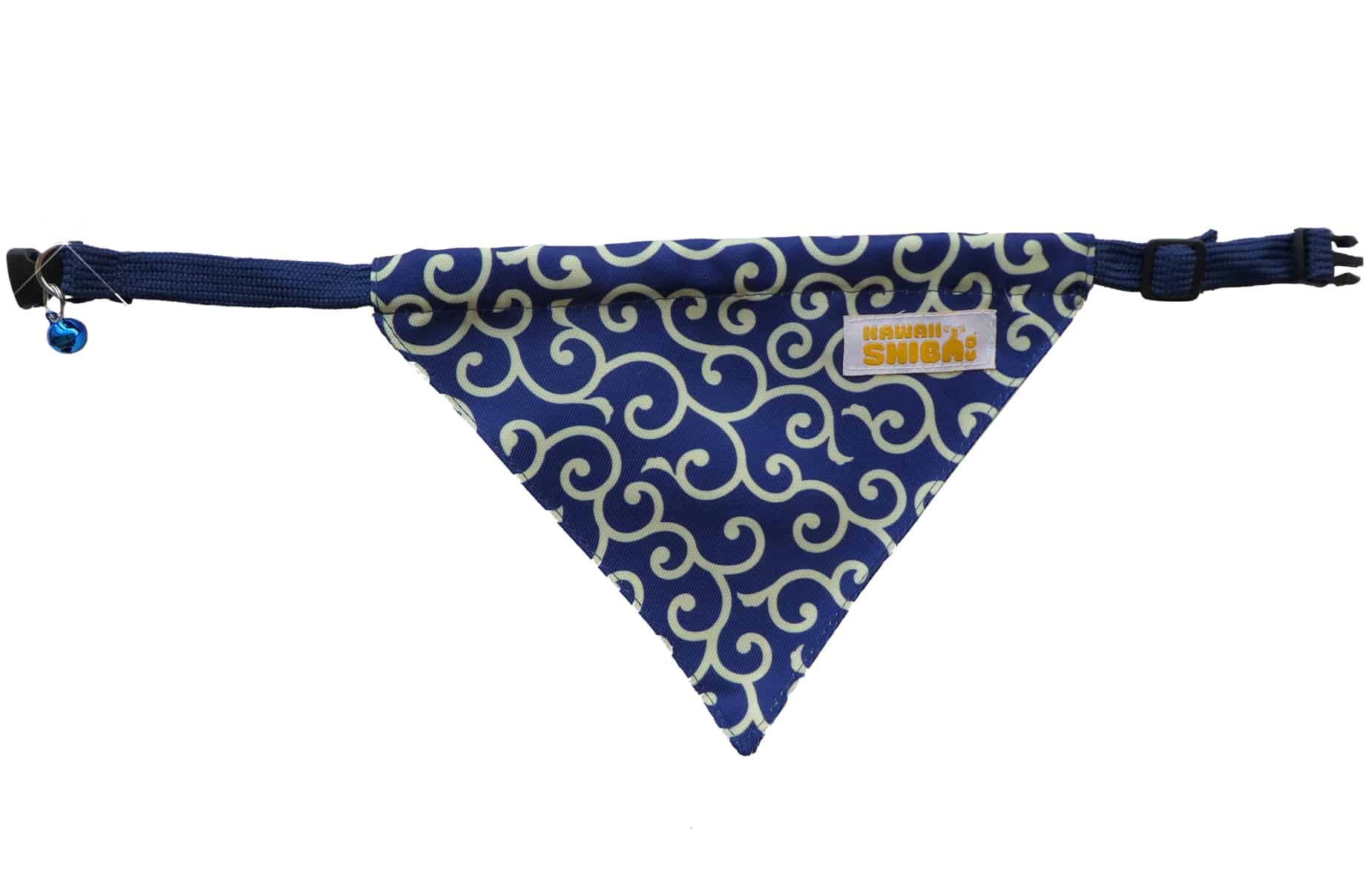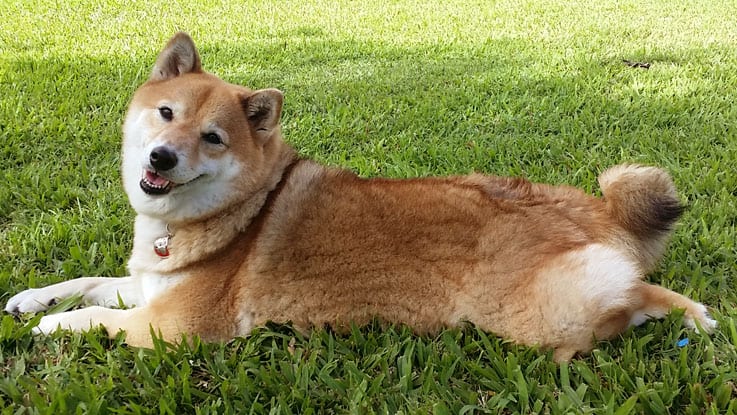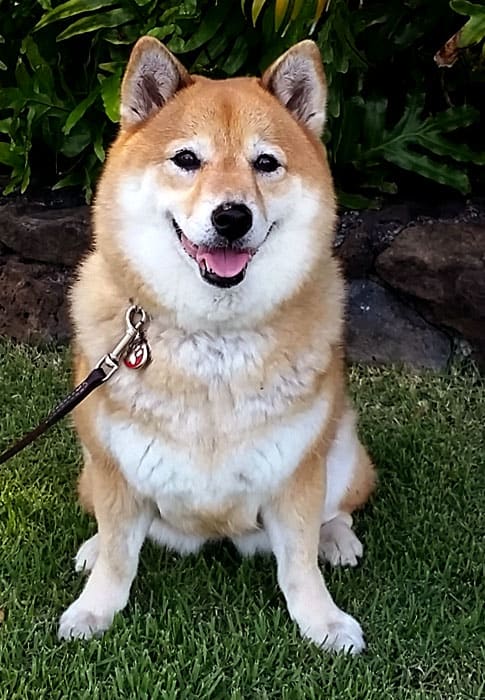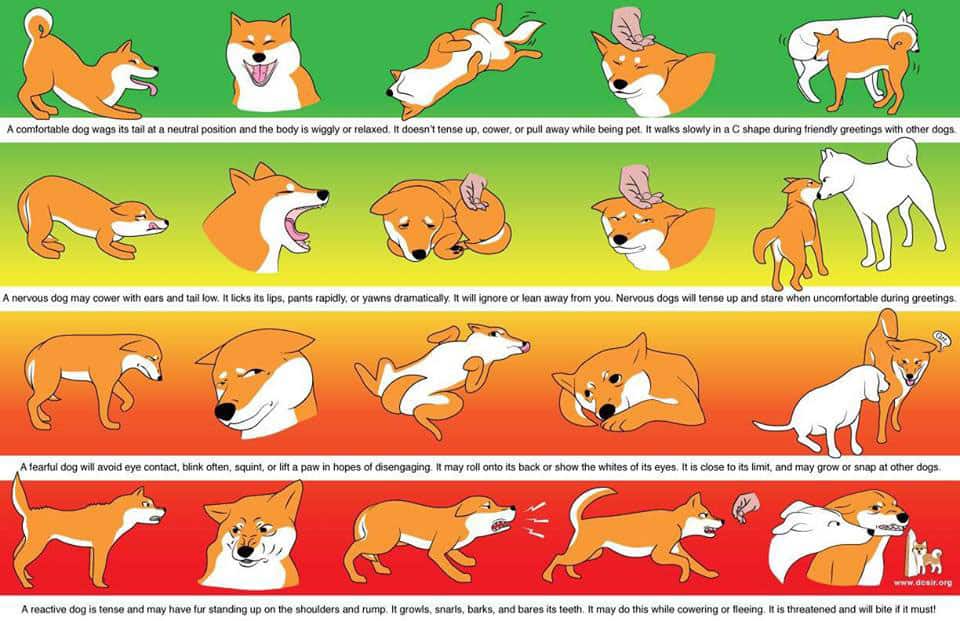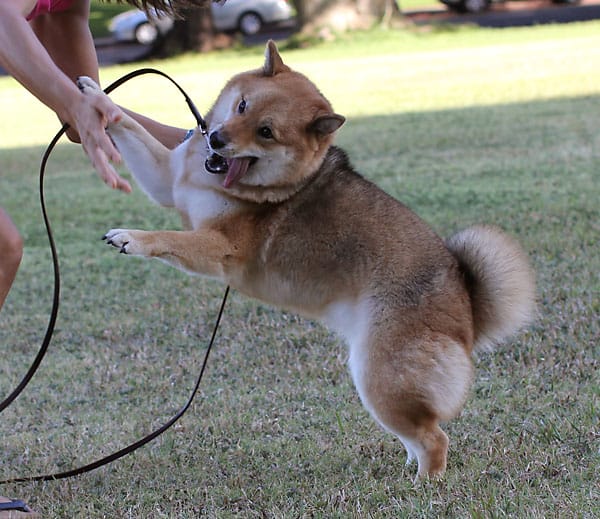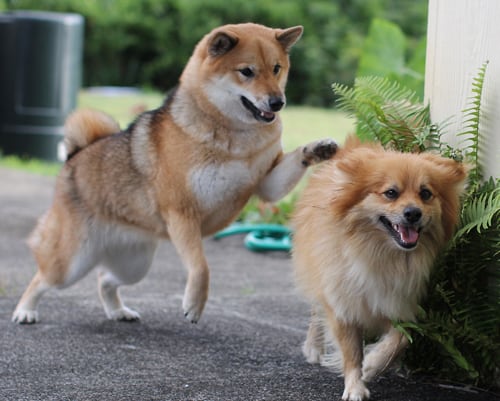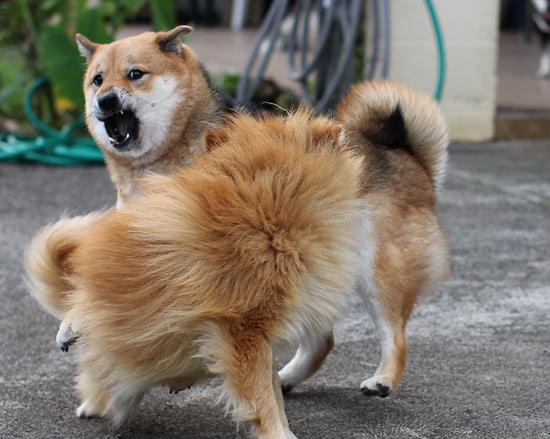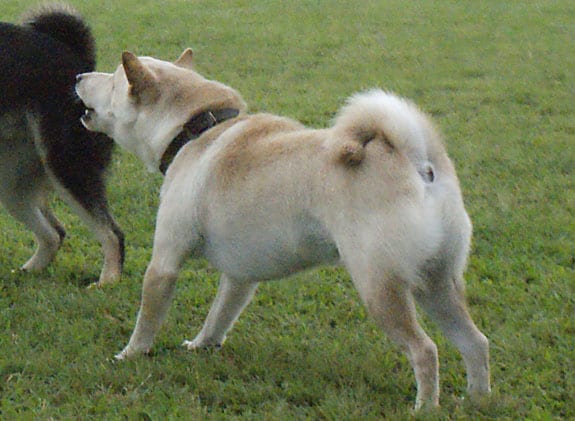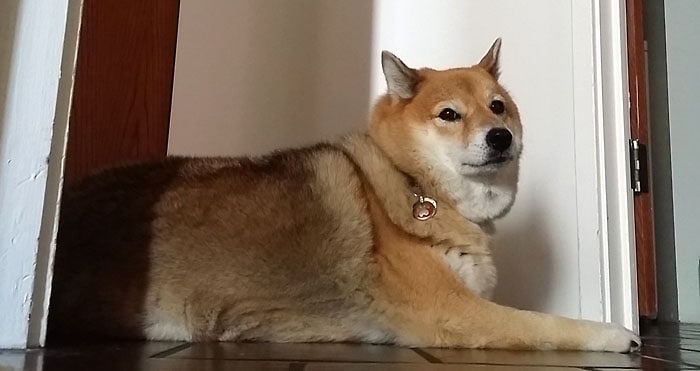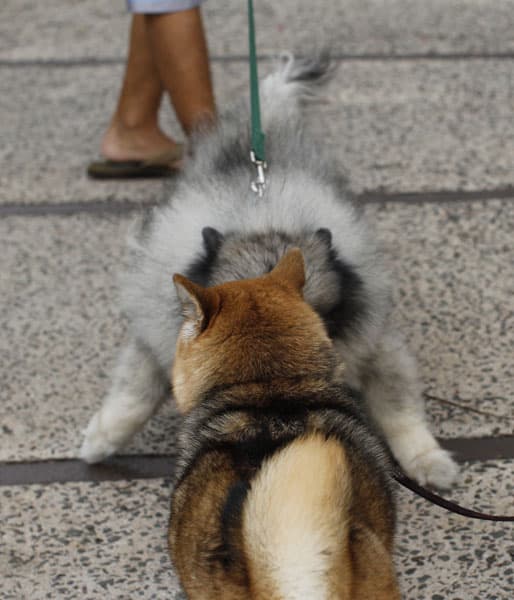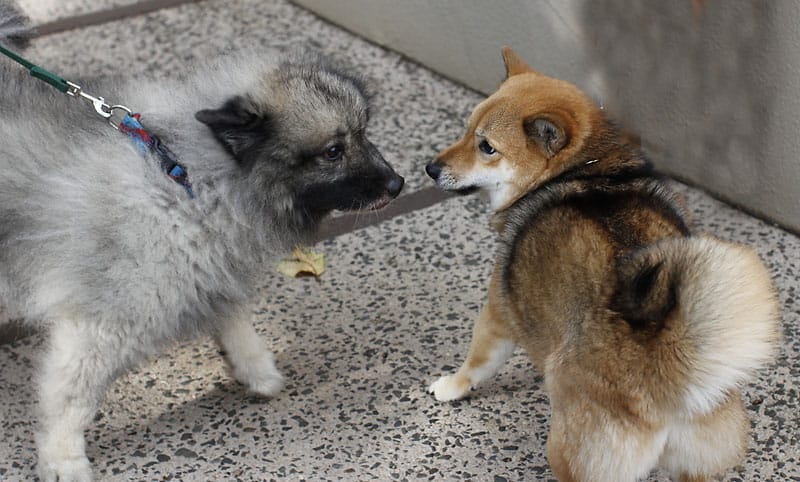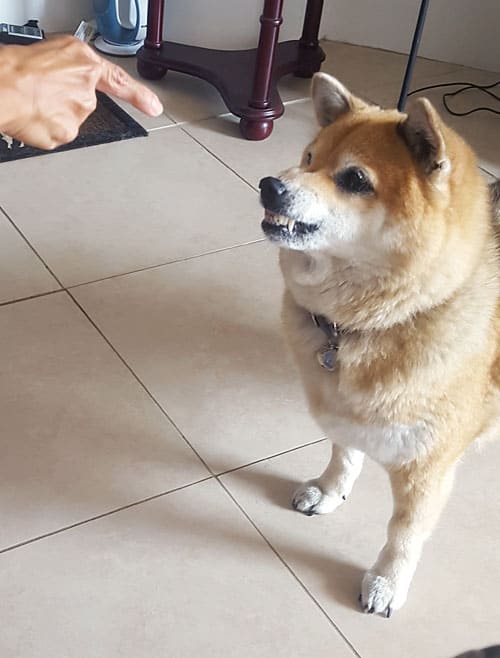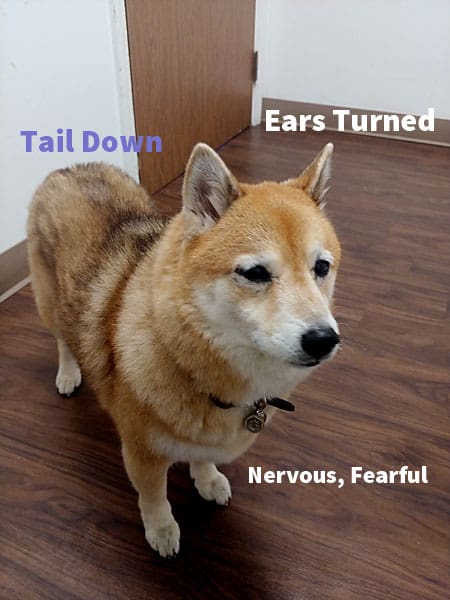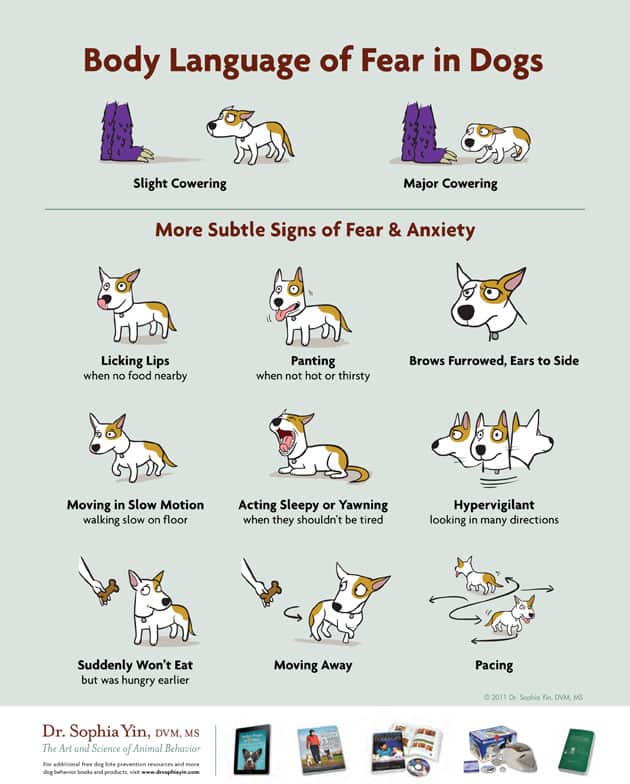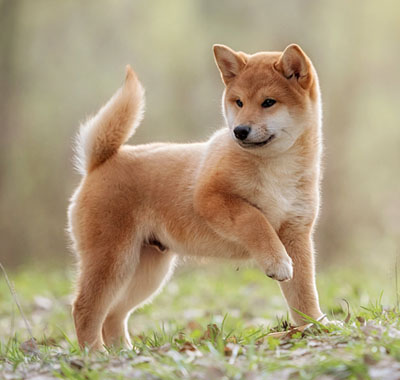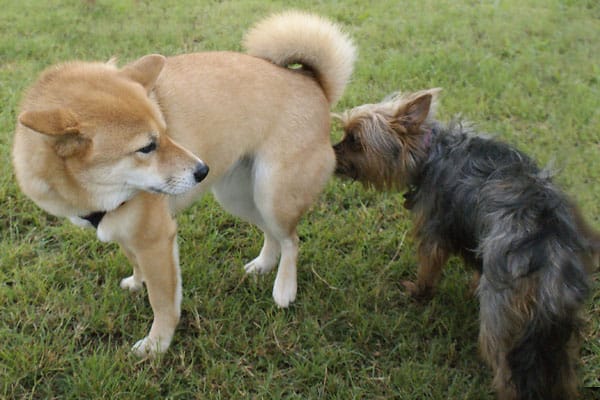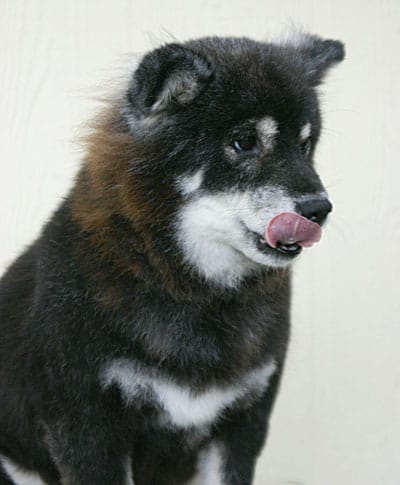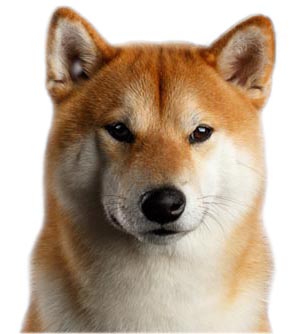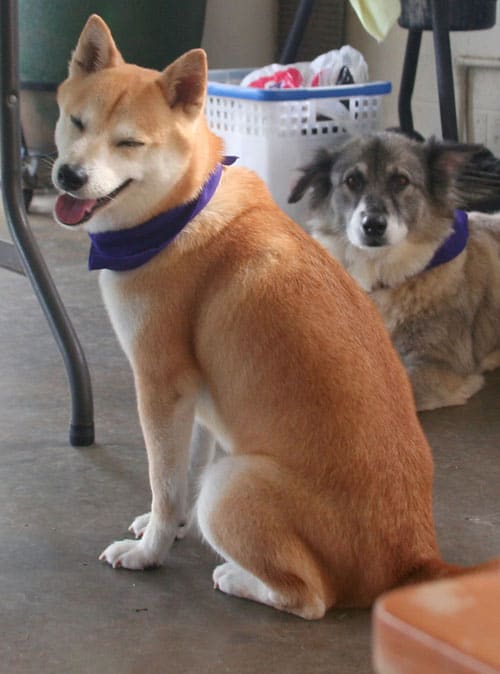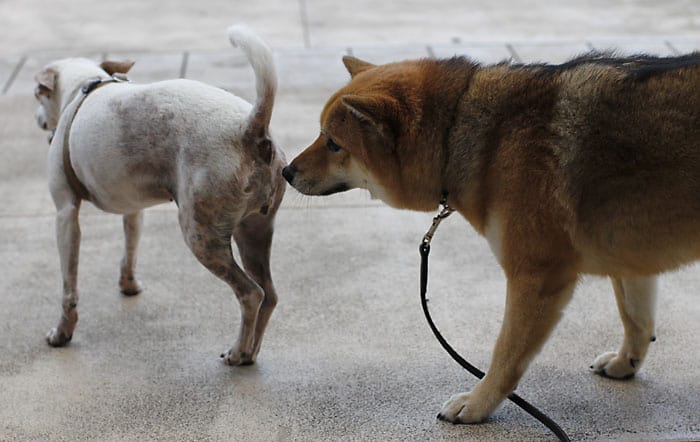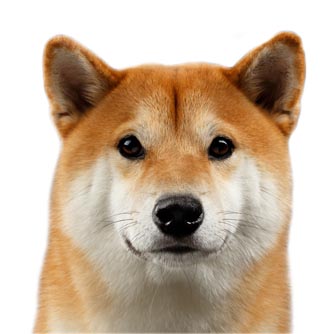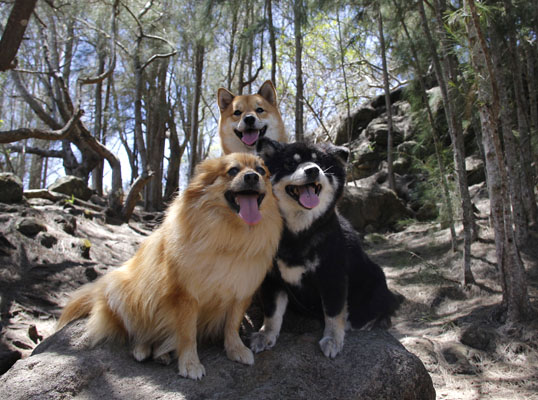BACK IN STOCK…
Karakusa Bandanas
As a dedicated Shiba Inu owner, you have probably found yourself more than once that you’d like to know what’s going on in your Shiba Inu’s cute and fluffy head.
What are they thinking as they sploot and stretch and mlem?
Unlike humans, dogs can’t verbalize their thoughts and feelings, so most of their communication is done through nonverbal movements, body and facial expressions.
Most dog owners will eventually pick up on certain habits, such as the invitations to play by bowing or ears pinned back in fear or aggression.
But to truly get to the bottom of what your Shiba Inu is trying to say means knowing more than overtly readable cues.
If you’re ready to learn the language of dogs, keep on reading!
Happy and Relaxed Shiba Inu
The Six Basic Dog “Moods” or Communication Signals
In terms of dog communication, there are five common dog communication signals.
- Relaxed – Neutral
- Playful
- Aroused
- Anxious / Upset
- Aggressive
- Fearful
Ideally, we want to try and keep our Shiba Inus in a relaxed and happy state. Therefore, we must learn to read their body language to understand when then are in a fearful, anxious, or aggressive mood.
Sometimes dogs can exhibit more than one communication signal at a time. For example a fearful dog can quickly snap into an aggressive dog in an instant.
Shiba Inus in ‘Neutral’
Relaxed or “neutral” positions in dogs are similar to humans in that, the neutral expression means that the dog is “relaxed” and is not responding positively or negatively to any stimulus.
Every Shiba is different, and you need to be able to realize what that neutral position is for your Shiba Inu before you can start to delegate meaning to other motions.
For instance, a Shiba Inu that has a low-hanging tail might not be depressed or fearful. It’s just that particular dog’s neutral position.
Relaxed and neutral Shiba Inus are happy Shiba Inus that often express their beautiful smile.
Happy and comfortable Shiba Inus will readily accept handling and will be keen and curious to explore new situations.
Playful Shiba Inu Body Language
Let’s start with the most typical mark of a Shiba Inu who is ready to play: bowing.
Dogs of any breed, big and small, will use bowing as a sign to show us that they are ready to rumble and are not trying to be threatening.
Usually, their tale will be wagging as they extend their front paws and legs towards the person / animal they want to engage with.
The demeanor is puppy-like. Relaxed yet rambunctious.
Watching playful canines cavort around with one another is a great way to learn how they express themselves.
While it might look like rough housing, the bumps, body-checking, growling, barking, wrestling, and rushing are fun and games—most of the time.
Sometimes, one dog will be far more aggressive or energetic than the other, and you will see that after the initial playfulness, the less willing playmate will start to shrink back, lay down, pin their eyes back, and cower.
Another sign of playfulness is when you see your dog lying on the ground, staring intently at you or another playmate.
This low stance might look like your Shibe is trying to be intimidating, but in reality, it’s practiced patience—almost similar to the way a cat coils up to pounce on a mole hill.
As long as both dogs have wide eyes and ears pointed forwards, both are still in the mood to play.
The happiest of expressions are at the top in the green. And as devoted Shiba Inu owners, it’s best to strive to have our Shiba Inus display these expressions.
While happiness isn’t limited to these five cues, the overall pattern is the same: half-moon eyes, upright eyes, softness in the body, and C-curves in the body whenever the dog is around another dog they like or someone that they trust wholeheartedly.
Aroused / Excited Shiba Inu
The causes of high arousal / excitement in Shiba Inus can be due to both positive and negative stimulus.
Dogs in shelters usually display high arousal (barking, jumping, crying) due to their confinement, lack of activity, and socialization.
Shiba Inus can display high arousal when they are positively reacting to a favorite person, toy, or food.
Arousal signals are often coupled with other signals such as fear and aggression. For example, a male Shiba Inu may get very excited when he sees another a male he doesn’t like and soon turn aggressive if triggered.
Anxious / Upset Shiba Inu
The ears serve as handy guides for picking up on fear and anxiety in dogs.
Referring again to the picture above, if you see a Shiba Inu with their ears flat against their heads, it means they are acting submissive or anxious about something.
This is different from airplane ears which conveys happiness.
Flattened ears can also show that confidence has decreased as a result of something.
If the ears moved from forward and pointed to flat, it could be a sign that your dog no longer cares for whatever had grabbed that attention moments again.
Again, you shouldn’t confuse ears that are pinned down and back with ears that are moving forward and back or just flopped out sideways.
When the ears are moving instead of remaining down, this means that your dog is actually searching for more information – basically wondering what’s going on.
They’re calculating what to do.
So, in a training scenario, you want to see the ears moving around, because your pup is receptive to what is going on.
Other signs of anxiety and fear can be seen in the eyes. The first signal is “cutting the eyes,” where the nose is pointed in one direction and the eyes another, kind of like a sidelong glance.
This shows nervous curiosity or restraint, much like it would in a person. A famous example of this would be the original Doge photo.
Next, we have “whale eye” or “showing the whites.” Dogs rarely show the whites of their eyes, and its usually because the dog is looking so far away from what is making them nervous or annoyed.
Another one that is obvious on breeds with looser skin, such as Shiba Inu, Retrievers, Labradors, and the like, would be a pinched brow.
Sure, Shibes don’t have eyebrows, but you can tell when they are furrowing their brow in thought.
Unlike humans who will furrow their brows when concentrating on something or in a moment of dubiousness, dogs pinch their brows to show intense worry about something.
The following infographic from famed veterinarian Sophia Yin’s website may be helpful with detecting the visual cues from your Shiba Inu or another dog that shows discontentment and anxiety:
Aggressive Shiba Inu
Aggression is actually a natural behavior for most animals and is usually set off by a perceived threat. (physical harm, protecting resources).
For most dogs, particularly Shiba Inus – aggressive body postures serve more as a warning and doesn’t usually lead up to an attack.
In the above images, the first image shows the Shiba flicking her back and not receptive to the greeting. The second image shows the Shiba Inu tensing up with a hard stare basically saying “back off”. If the other dog doesn’t comply the Shiba could quickly shift to more aggressive reactions.
When the Shiba growls, shows teeth, or stiffens, it’s a sign to back off – or else.
As previously mentioned, communication signals can be displayed either consecutively or simultaneously.
For example a fearful Shiba Inu may turn aggressive if their fear signals where not properly interpreted.
Fearful Shiba Inu
The fearful communication signal is one of the easier signals to interpret because it usually expressed with the entire body.
A fearful Shiba Inu might have his tail tucked, his ears flattened, his body hunched all while trembling uncontrollably.
More subtle fear signals include the licking of lips, panting, yawning, and avoiding eye contact.
A dog experiencing fear can also be either hyper vigilant and tense or the extreme opposite – slow and cautious.
Fearful Shiba Inus sometimes “poof” out their coat in attempt to make themselves appear larger to what they perceive as a threat.
Fearfulness can quickly turn to aggressiveness if the stimulus continues and the Shiba continues to feel threatened.
The Body Language of The Shiba Inu Tail
The tail is one of the most recognizable parts of the Shiba Inu body, but it is also the most misunderstood part of their body.
The reason is because that you can never get a clear picture by just focusing on the tail without considering other factors.
For instance, there’s the misunderstanding that a wagging tail means a happy dog. The reality of a wagging tail shows an energetic, stimulated dog.
Now, that energy could be playful energy or hostile energy, depending on the situation.
Wagging has also been proven to be a form of communication in and of itself.
Dogs have different types of wags.
The directions of the wag, as well as the speed and range of the swing, have meaning, such as: (Keep in mind that the directions mentioned are the directions relative to the dog, so when I put left or right, it means the dog’s right, which would be your left if the two of you were looking at one another face-to-face.)
- Leftward wagging – when a dog wags their tail from the middle to the left, it’s called the “avoidance axis.” In other words, your dog is saying, “Stay back, I don’t want to play with you.”
- Rightward wagging – when the tail moves from the midline to the dog’s right, this is a sign of wanting interaction. He’s asking for your attention. It can also be a sign of curiosity about whatever they are focused on.
- Fast wagging – this is the exclamation point of the dog world.
- Slow wagging – this shows uncertainty about what to do next. If the tail is hanging low, a slow wag can also mean loneliness or sadness.
- Low-carried tail – thinking back to neutral, when a dog carries their tail lower than usual, it means they are feeling unwell or are not energetic. It can always mean wanting to be left alone, but that shouldn’t be equated with fear. Most dogs do this because a high tail can read as wanting to challenge other dogs.
- High-carried tail – when a dog carries their tail higher than neutral position, it shows confidence and excitement.
Tail up and ready for adventure
Advanced Shiba Inu Communication Signals
So far we’ve covered the six basic communication signals, and how to read movements of the tail.
Now, let’s look at a few movements that can be used to express certain emotions.
These motions are often done whenever your Shiba Inu is feeling peaceful.
Research says the movements stem back from when dogs were still wild pack animals that needed to develop group signals every member of the pack would understand.
This would prevent misunderstandings (yes, even dogs can misunderstand one another) from occurring.
The problem is that many of these movements are subtle or happen in the blink of an eye. If you’re not paying full attention, you might miss these expressions:
- Nose licking
- Sniffing the ground
- Glancing away
- Yawning
- Slow blinking
- Showing ones back
- Laying down with a “humph”
- Moving slowly
Nose licking is often disregarding by owners, but you really shouldn’t pass it off as your Shibe doing what dogs do.
In reality, a nose lick is kind of like a shoulder shrug or a way to show ambivalence.
For example, if you are walking straight towards your Shiba Inu, you might see a nose lick. This is your dog saying, “You really shouldn’t be doing that, but whatever.”
In the dog world, walking straight at them is a sign of challenge.
Similarly, if you are walking around then turn to look at your Shiba Inu and they’re already staring at you, you might see a nose lick as their way of saying, “I’m just looking, don’t be offended.”
Yawning can mean a lot of different things, so you need to look at a combination of things to understand the meaning.
If it’s 2AM in the morning, that yawn is likely fatigue, not anxiety.
If however, your Shiba Inu begins yawning rather noticeably, she may be irritated or in an uncomfortable situation.
Blinking is used in a calming manner to tell you or another dog that your Shiba Inu didn’t mean to stare or give a hard gaze.
However, if your Shiba Inu suddenly glances away, you can think of this as being similar to cutting the gaze. It’s a strong signal that shows your dog has had enough.
If the Shiba has been playing with another dog who is rather forward and is feeling annoyed, you might see your companion look away.
Similar to looking away, turning around is much like humans turning their back on someone. It’s the dog’s way of screaming, “OMG, LEAVE ME ALONE” with expletives. It’s the teenager door slam in the parent’s face.
Lastly, there’s the slow movements. You can think of it as walking on eggshells but with an underlying meaning.
For instance, let’s say your Shiba Inu is deeply transfixed on something. When you call their name several times, growing in volume, they might slowly walk towards you to show reluctance.
Similarly, if you scold your Shiba or correct them, you might see slow movements afterward.
Much like the turnaround being the leveled-up look away, moving slowly will climax at laying down.
While this shouldn’t be seen as offensive, handlers can get flustered with dogs that do this. It’s actually a calming signal that is asking for some “me time.”
Dogs have over thirty calming signals ranging from nose licking to laying down, and it’s impossible to cover them all in this article.
But knowing what to look for can help with beginning to understand what your dog is asking for and how you can respond in turn.
Want to study more on doggy language? Check out the video entitled “Dog Communication: Dog Body Language” by Go Anywhere Dog, based in Minneapolis, MN.
You can start to see the visual representations of what’s being covered in this article. You can also see some of the calming signals.
Using Dog Body Language To Speak Shiba Inu
Now that you’ve learned a great deal of body language, how can you use these movements to converse with your Shiba?
Whenever possible, you should use the signals to show your Shiba Inu that you’re not a threat or trying to challenge them in any way.
For example, if you are coming up to a dog, you might want to interact with a calming glance away to show that you’re not staring.
You might want to yawn around your Shiba Inu to prompt relaxation.
Instead of coming straight at your Shibe, walking in a C-curve around them to the midpoint of their body and see if they react in turn.
Dog’s prefer to greet from behind instead of face to face
If your Shiba Inu doesn’t do the C-curve or raise their tail or bow down for play, they might just want to be left alone—especially if they look away.
When you want to pet a new or unfamiliar dog – don’t just go straight for the top of their head – they can see that as a threat.
Instead, try to invite yourself first by offering your hand for the dog to sniff.
If the dog looks relaxed and receptive, you can continue to pet the dog on their chest below their mouth.
When you pet a new dog below their mouth instead of on top of their head, you are showing that you trust the dog and you do not want to threaten him or her.
If you are dealing with an anxious or fearful Shiba Inu, try doing your best to help disassociate the stimulus with the fear reaction.
For example, if your Shiba Inu is noise fearful you will provide needed reassurance if your demeanor is calm, positive, upbeat, and confident.
You can try changing the mood by pretending your having the time of your life thereby visually informing your Shiba Inu that all is well and dandy.
Whatever you do, don’t react fearfully or negatively to the stimulus as that will make the Shiba Inu all the more fearful.
Just like going to another country and trying to speak the language of the locals, the more your encourage the use of the calming signals, the more your dog will trust and respect you.
Hopefully, you should be able to decipher your Shiba Inu’s body language a little better now.
As you start to read this body movements and use them, too, you might see a difference in how your Shibe interacts with you.
Remember, it might take some practice to accurately read what your furry friend is trying to tell you, but your relationship will grow because of it!
Thanks for visiting Myfirstshiba.com! We do our very best in providing our readers with awesome content about our beloved Shiba Inu breed. Some of our articles include reviews and recommendations to our favorite products. We do occasionally earn commissions from certain affiliate links that help support our work and mission. Thanks again for visiting. Shiba Kisses To All!
